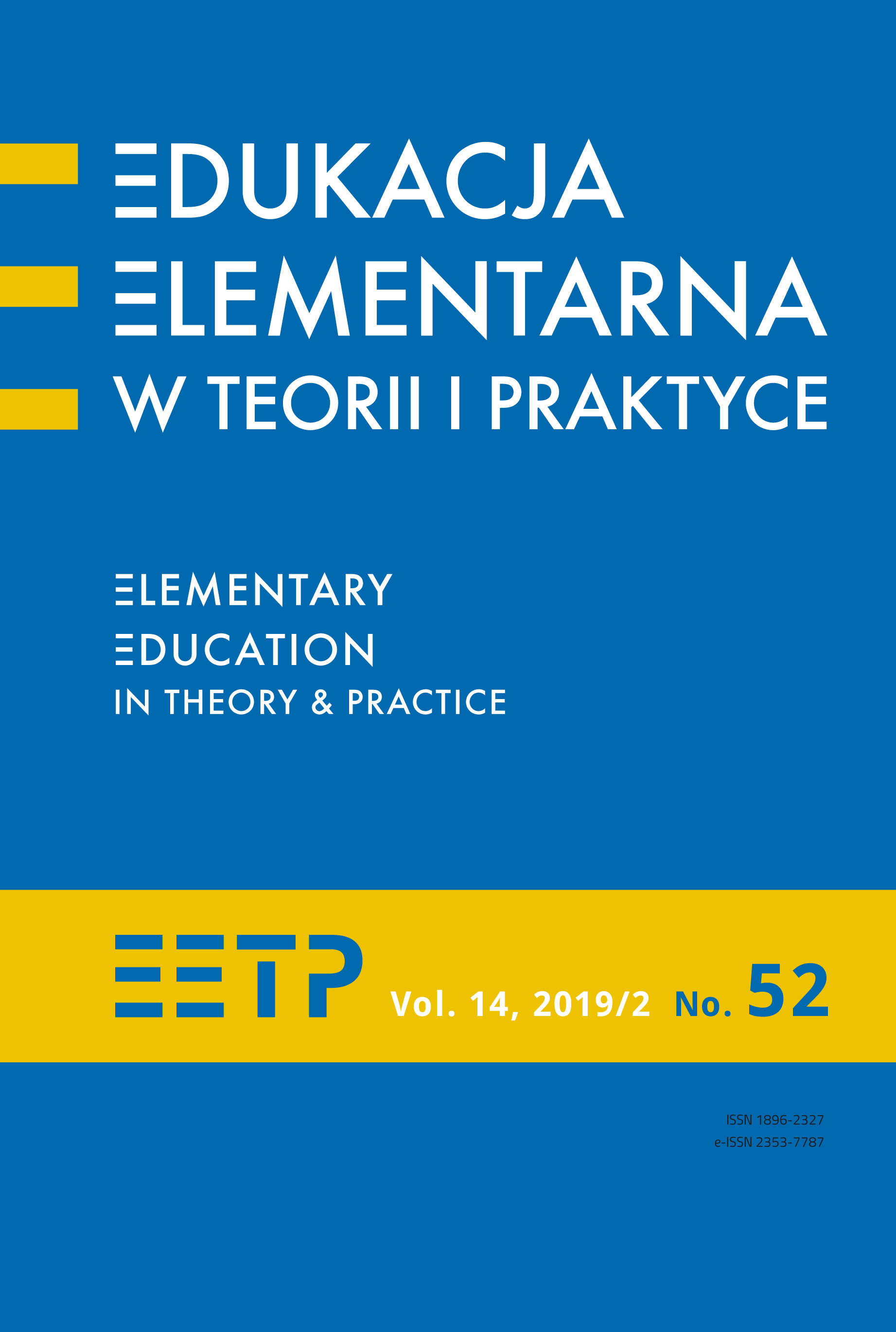Methods of Educational Support Used by Teachers of Classes I-III – Research Report
Abstract
The quality of the educational system functioning depends on many factors among which the person of the teacher, his accrual education, and preparation for working with children are the most important. The teacher’s “equipment” should not only be based on the colloquial experience, but, first of all, it should be well rooted in the contemporary theoretical pedagogical thought. While preparing for the classes, the teacher should unconditionally know the principles of the didactic-educational work with children, the methods of teaching and learning, organisational forms of working with students, as well as didactic tools that are to support his/her work. This work aimed at learning the opinion of teachers of classes I-III on the use of methods supporting the students’ educational activity. The main research method was a diagnostic survey with the technique of a questionnaire. The research made it possible to obtain the answers to the research problems formulated in the work. According to the research results, teachers see the need to focus on the process of learning, and not teaching. The student becomes a subject with his/her own interests and individual needs, and he/she has the right to intelligent development in different aspects of his/her life. It is the most important objective of integrated education which we are now trying to achieve through, inter alia, the use of various methods of the students’ educational support. Such a way of acting, based on creative activity, determines the maximization of the child’s developmental chances. In his personal actions, the student, using the experience gained during the classes when activating, problem, analytical and verbal methods are applied, becomes a competent, creative unit who can take up all challenges, and then deal with them in everyday life.
References
Bereźnicki F. (2008). Podstawy dydaktyki, Kraków: Oficyna Wydawnicza Impuls.
Dmitruk-Sierocińska K. (2015). Znaczenie aktywności i metod aktywizujących w edukacji zintegrowanej, „Edukacja Elementarna w Teorii i Praktyce”, nr 3(37), s. 29-39.
Duraj-Nowakowa K. (1998). Integrowanie edukacji wczesnoszkolnej. Modernizacja teorii i praktyki, Kraków: Oficyna Wydawnicza Impuls.
Dzierzgowska I. (2009). Jak uczyć metodami aktywnymi, Warszawa: Wydawnictwo Fraszka Edukacyjna.
Galant J. (1987). Dostrzeganie i rozwiązywanie problemów w klasach początkowych, Warszawa: WSiP.
Kameduła E. (1998). Ewaluacja metod kształcenia, [w:] K. Denek, F. Bereźnicki (red.), Tendencje w dydaktyce współczesnej, Toruń: Wydawnictwo Adam Marszałek, s. 130-133.
Karbowniczek J., Klim-Klimaszewska A. (2016). Edukacja wczesnoszkolna w teorii i praktyce, Kraków: Wydawnictwo WAM.
Klus-Stańska D., Nowicka M. (2005). Sensy i bezsensy edukacji wczesnoszkolnej, Warszawa: Wydawnictwo WSIP.
Krzyżewska J. (1998). Aktywizujące metody i techniki w edukacji wczesnoszkolnej, Część I, Suwałki: Wydawnictwo AU OMEGA.
Kujawiński J. (1997). Edukacja i samoedukacja wczesnoszkolna w poczuciu współpodmiotowości uczniów i nauczycieli, „Nauczyciel i Szkoła”, nr 2(3), s. 14-20.
Kujawiński J. (1998). Metody edukacyjne nauczania i wspierania w klasach początkowych, Poznań: Wydawnictwo Naukowe UAM.
Kupisiewicz C. (2000). Dydaktyka ogólna, Warszawa: Wydawnictwo Graf Punkt.
Michalak R. (2004). Aktywizowanie ucznia w edukacji wczesnoszkolnej, Poznań: Wydawnictwo Naukowe im. Adama Mickiewicza.
Okoń W. (1978). Nauczanie problemowe we współczesnej szkole, Warszawa: WSiP.
Okoń W. (1996). Wprowadzenie do dydaktyki ogólnej, Warszawa: Wydawnictwo Akademickie „Żak”.
Copyright (c) 2019 Elementary Education in Theory and Practice

This work is licensed under a Creative Commons Attribution-NoDerivatives 4.0 International License.
- When submitting a text, the author declares that he/she is the Author of the article (hereinafter referred to as the “Work”) and:
- he/she owns the exclusive and unlimited copyright to the Work,
- is entitled to dispose of the copyright to the Work.
Declares that it does not infringe any third party copyrights or legal rights.
Declares that there is no conflict of interest.
2. At the same time, the Author grants the Ignatianum University in Cracowa royalty-free, non-exclusive and territorially unlimited licence to use the Work in the following fields of exploitation:
- recording the Work in a hard copy, as well as on a digital or magnetic medium;
- reproduction of the Work using any technique, without limitation of the number of editions or copies;
- distribution of the Work and its copies on any medium, including marketing, sale, lending, and rental;
- introduction of the Work into a computer memory;
- disseminating the Work in information networks, including in the Internet;
- public performance, exhibition, display, reproduction, broadcasting and re-broadcasting, as well as making the Work available to the public in such a way that everyone can have access to it at a time and place of their own choosing;
- within the scope of dependent rights to the Work, including in particular the right to make necessary changes to the Work resulting from editorial and methodical development, as well as to translate the Work into foreign languages;
The licence is granted from the moment of the transfer of the Work to the Ignatianum University in Cracow. The Ignatianum University in Cracow is entitled to grant further sub-licences to the Work within the scope of the right granted. The licence is time-limited and it is granted for a period of 15 years, starting from the date of its granting.
Authors are permitted and encouraged to publish their text online (e.g. in their institution’s repository or on the institution’s website) before or during the submission process as this may lead to beneficial exchanges, as well as earlier and greater citation of the published text (See The Effect of Open Access). We recommend using any of the following portals of research associations:
- ResearchGate
- SSRN
- Academia.edu
- Selected Works
- Academic Search




